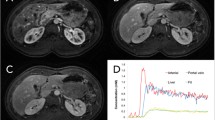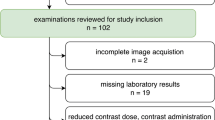Abstract
The 133Xe inhalation technique for liver blood flow measurements was modified by using a gamma camera for data acquisition. Desaturation curves were derived from regions of interest (ROIs) over different parts of the liver, the lung and that lung area overlapping the liver, the liver hilus, and the splanchnic area. An additional liver scan with 99mTc-sulfur colloid facilitated the choice of these regions and allowed the estimation of the total liver volume. Thirteen healthy volunteers were examined under baseline conditions. Uncorrected blood flow values derived from the 133Xe-washout curves over the liver (40±10 ml/min/100 g liver) were lower than those found with other methods. A multicompartment model, based on the input functions calculated from the lung and splanchnic curves, gave values in accordance with those reported in the literature (94±20 ml/min/100 g or 1,356±382 ml/min/liver; mean liver volume: 1,475±227 g). Some methodologic limitations are shared with other invasive or noninvasive techniques.
Similar content being viewed by others
References
Andersen AM, Ladefoged J (1967) Partition coefficient of 133-xenon between various tissues and blood in vivo. Scand J Clin Lab Invest 19:72–78
Aronsen KF, Ericsson B, Fajgelj A, Lindell SE (1968) The clearance of 133xenon from the liver intraportal injection in man. Nuklearmedizin 5:241–245
Birtch AG, Casey BH, Zakheim RM (1967) Hepatic blood flow measured by Krypton-85 clearance technique. Surgery 62:174–180
Buchali K, Schimmelpfennig W, Sest Ch, Maluszek S, Sapia CH, Correns HJ (1980) Influence of posture on hepatic blood flow. Eur J Nucl Med 5:303–304
Buchali K, Zimmermann HB, Schneider G, Strangfeld D (1974) Zur Methode der Messung der portalen Durchblutung mit Radioxenon. Radiobiol, Radiother (Berl) 1:213–216
Conn HL (1955) Measurement of organ flow without blood sampling. J Clin Invest 34:916–917
Darle N (1970) 133Xenon clearance and liver blood flow. An experimental study in the cat. Acta Chir Scand (Suppl) 407:1–64
Dietze G, Wicklmayr M, Czempiel H, Henftling HG, Hepp KD, Mehnert H (1975) Zur Analyse der Lebervenösen 133Xenon-Clearance nach Zufuhr des Gases durch Inhalation. Klin Wochenschr 53:639–640
Gelin LE, Lewis DH, Nilsson L (1968) Liver blood flow in man during abdominal surgery. Acta Hepatosplenologica 15:13–20
Grayson J, Mendel D (1965) Physiology of the splanchnic circulation. Edward Arnold Ltd., London
Greenway CV, Stark RD (1971) Hepatic vascular bed. Physiol Rev 51:23–65
Kitani K, Ladefoged J, Winkler K, Tygstrup N (1970) Determination of blood flow and lipid content of the liver by the simultaneous use of 85-Kr and 133-Xe in patients and isolated pig livers with portal perfusion. J Nucl Med 11:335–341
Künzli HF, Fridrich R (1972) Zur Bestimmung der relativen portalen Leberdurchblutung mit Xenon-133 nach Kanulierung der Umbilicalvene. Dtsch Med Wochenschr 97:1159–1161
Levy ML, Palazzi HM, Nardi GL, Bunker JP (1961) Hepatic blood flow variations during surgical anesthesia in man measured by radioactive colloid. Surg Gynecol Obstet 112:289–294
Mackenzie RJ, Leiberman DP, Mathie RT, Rice GC, Harper AM, Blumgart LH (1976) Liver blood flow measurement: the interpretation of xenon-133 clearance curves. Acta Chir Scand 142:519–525
Ohnhaus EE (1979) Methods of the assessment of the effect of drugs on liver blood flow in man. Br J Clin Pharmacol 7:223–229
Ohnhaus EE, Itin F (1981) The estimation of the partition-coefficient of xenon following induction of the liver microsomal enzyme system. International Congress of Pharmacology, Tokyo, Abstract Volume, p 696
Ohnhaus EE, Muff S (1981) The xenon partition-coefficient in experimentally induced liver disease in rats. International Congress of Pharmacology, Tokyo, Abstract Volume, p 696
Peiper U, Lutz J, Wullstein HK (1969) Über die gegenseitige Beeinflussung der Durchblutung im Bereich von V. portae und A. hepatica. Z Kreislaufforsch 58:197–209
Rees JR, Redding VJ, Ashfield R (1964) Hepatic blood flow measurement with xenon-133. Evidence for separate hepatic-arterial and portal venous pathways. Lancet ii:562–563
Sachs L (1978) Statistische Auswertungsmethoden. Springer, Berlin, Heidelberg, New York
Schmitz-Feuerhake I, Huchzemeyer H, Reblin T (1975) Determination of the specific blood flow of the liver by inhalation of radioactive rare gases. Acta Hepato-Gastroenterol 22:150–158
Strandell T, Erwald R, Kulling KG, Lundbergh P, Marious O, Wiechel KL (1973) Measurement of dual hepatic blood flow in awake patients. J Appl Physiol 35:755–761
Strauss E, Schmidt E, Raia S, Kieffer J (1980) Intrahepatic percutaneous deposition of radioactive xenon (133Xe) as a means of measuring hepatic blood flow. Hepatogastroenterology 27:99–103
Szabo G, Benyo I, Sandor J, Benyo Z (1976) Estimation of hepatic blood flow in the dog with the Xe133 and hydrogen wash-out, Au198-Colloid uptake techniques and with the electromagnetic flowmeter. Res Exp Med 169:69–76
Tobias CA, Jones HB, Lawrence JH, Hamilton JG (1949) The uptake and elimination of Krypton and other intert gases by the human body. J Clin Invest 28:1375–1385
de Valois JC, Smith J, Peperkamp JPC (1970) A computer program for the determination of cerebral blood flow. Biomed, Comput 1:49–60
Veall N, Mallett BL (1966) Regional cerebral blood flow determination by 133Xe inhalation and external recording: the effect of arterial recirculation. Clin Sci 30:353–369
Walk L (1960) Roentgenologic determination of the liver volume. Acta Radiol 55:49–56
Author information
Authors and Affiliations
Rights and permissions
About this article
Cite this article
Ohnhaus, E.E., Noelpp, U.B., Ramos, R. et al. A modification of the 133Xe inhalation method for the measurement of liver blood flow in man. Eur J Nucl Med 10, 125–128 (1985). https://doi.org/10.1007/BF00252719
Received:
Issue Date:
DOI: https://doi.org/10.1007/BF00252719




